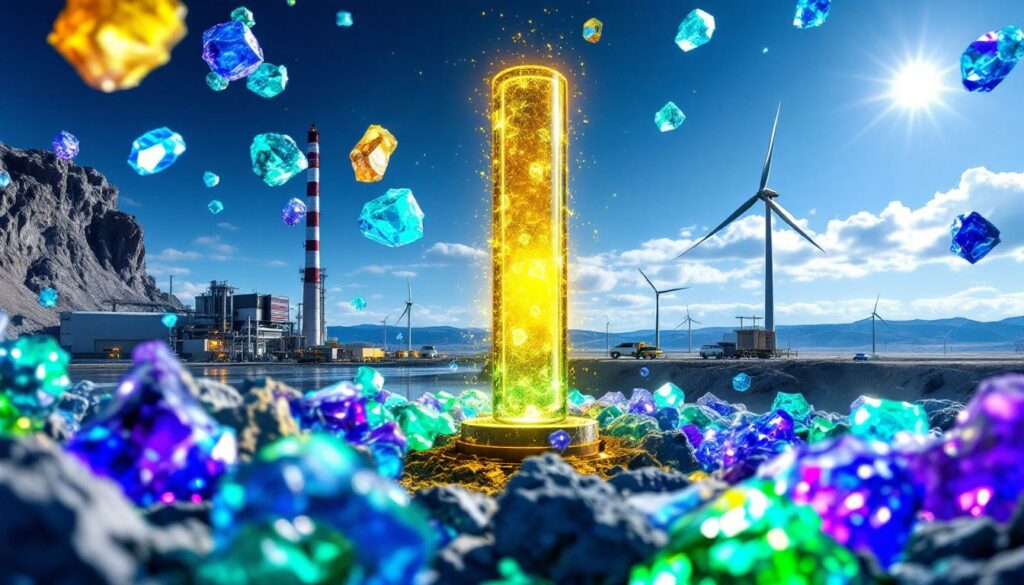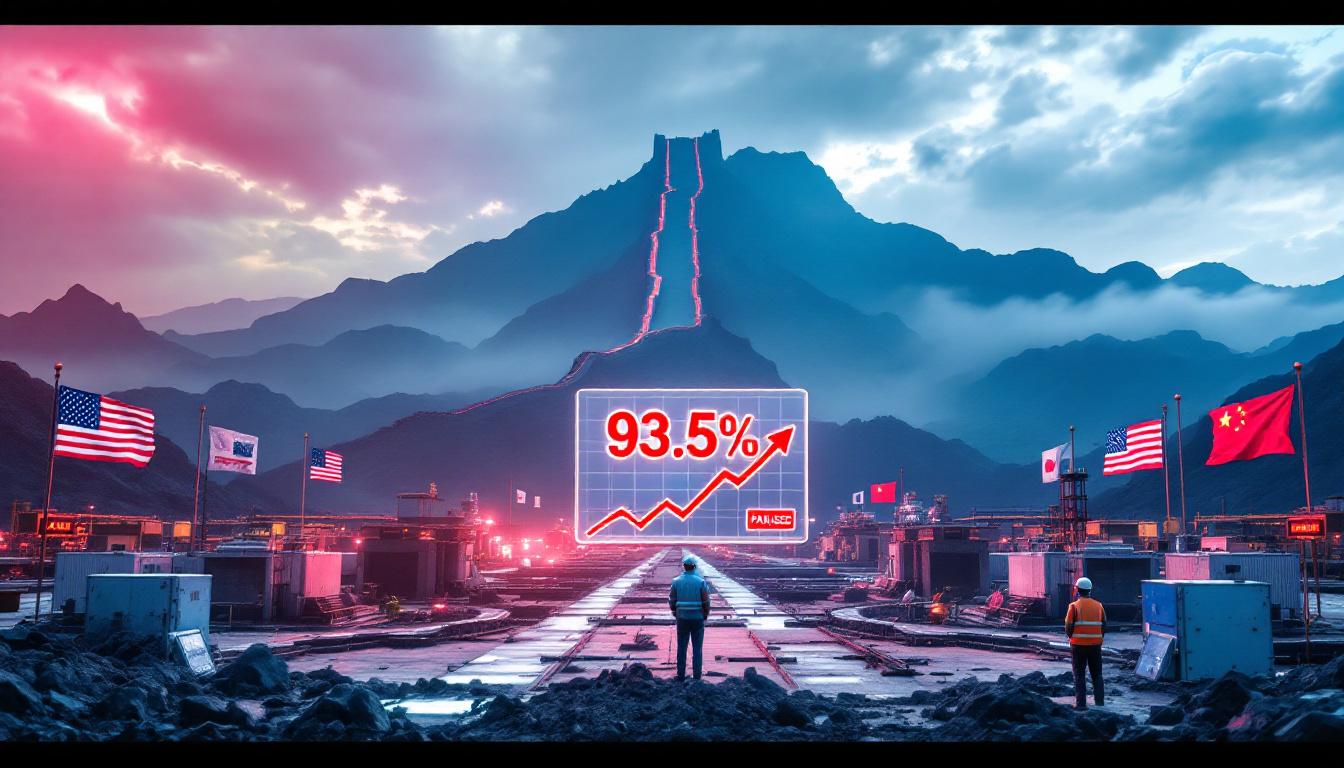The Power of Uranium: Building a Critical Minerals Hub in the US
What is Energy Fuels and Why Does It Matter?
Energy Fuels represents a unique player in the critical minerals sector, distinguishing itself by dual-listing on both the NYSE American (UUUU) and Toronto Stock Exchange (EFR). Unlike traditional mining companies focused on a single resource, Energy Fuels has strategically positioned itself as the architect of America's critical minerals hub, with uranium production as its foundation.
The company owns and operates the White Mesa Mill in Utah—the only conventional uranium processing facility in the United States—giving it an exceptional competitive advantage in the domestic market. This facility serves as the cornerstone of Energy Fuels' expanding operations, processing both uranium and rare earth elements under a single roof.
The Unique Position in Critical Minerals
As the largest uranium producer in the United States, Energy Fuels has leveraged its existing infrastructure to create a vertically integrated operation spanning multiple critical mineral supply chains. The company's portfolio extends beyond uranium to include rare earth elements, with particular emphasis on heavy mineral sand deposits containing monazite.
According to CEO Mark Chalmers, "We are a critical mineral company building a critical mineral hub built around uranium… expanding into producing and mining rare earth elements." This diversification strategy addresses multiple supply chain vulnerabilities simultaneously.
The White Mesa Mill can process approximately 15,000 tons of monazite sands annually, extracting both uranium and rare earth oxides from the same material—a unique capability that maximizes resource utilization and operational efficiency.
Bridging Uranium and Rare Earth Elements
Energy Fuels' business model represents a strategic bridge between two essential mineral sectors that rarely overlap. By utilizing existing uranium processing infrastructure for rare earth separation, the company achieves significant cost advantages compared to competitors building greenfield facilities.
This dual focus creates natural operational synergies, as the company can alternate between uranium market dynamics and rare earth processing campaigns at its White Mesa facility, optimizing production based on market conditions and maximizing the return on its capital investments.
The company processes monazite sands containing approximately 50% rare earth oxides as a byproduct of uranium production, employing sophisticated solvent extraction technology for rare earth separation. This technical capability sets Energy Fuels apart from most competitors, who remain in planning or pilot stages.
Why Are Critical Minerals Gaining Strategic Importance?
Critical minerals have emerged as a cornerstone of national security and technological sovereignty, prompting unprecedented government attention and corporate investment. The urgency surrounding these resources stems from their indispensable role in everything from defense systems to renewable energy infrastructure.
The Growing Dependency Concern
The United States faces alarming supply vulnerabilities for key minerals. According to the U.S. Geological Survey's 2024 Mineral Commodity Summaries, China controls approximately 70% of global rare earth production and a staggering 90% of heavy rare earth elements. Even more concerning, the Department of Energy reports that the U.S. imported 100% of its dysprosium and terbium in 2023—two elements crucial for advanced technologies.
This dependency creates significant national security and economic risks. As global tensions rise and supply chains face disruption, governments and corporations have begun urgent efforts to develop alternative sources. The Inflation Reduction Act of 2022 codified this concern, mandating that 40% of critical minerals energy security materials in certain applications must come from the U.S. or allied nations by 2027.
Government and Corporate Recognition
Recent actions demonstrate the growing prioritization of critical minerals. The Department of Defense awarded MP Materials $35 million for heavy rare earth separation capabilities, while technology giant Apple has made strategic investments to secure its neodymium-praseodymium (NdPr) supply chain.
As Chalmers notes, "The realization is that dependency on China for modern technologies is driving change." This awareness has created unprecedented opportunities for companies with established critical mineral assets in Western jurisdictions.
The strategic importance of these materials transcends traditional market dynamics—they represent the building blocks of technological sovereignty. Companies positioned to provide domestic supplies stand to benefit not only from market demand but also from growing government support programs designed to rebuild critical supply chains.
How Is Energy Fuels Positioned in the Rare Earth Market?
Energy Fuels has moved beyond planning and pilot phases to establish itself as a commercial producer of high-value rare earth products. This positions the company in an elite category among Western rare earth developers—those with proven production capabilities rather than just theoretical plans.
Producing Commercial-Grade Products
The company has successfully produced commercial quantities of neodymium-praseodymium (NdPr) oxide exceeding 99% purity, suitable for permanent magnet manufacturing. This achievement represents a critical milestone, as NdPr constitutes approximately 80-90% of the value in most rare earth deposits.
Energy Fuels is also recovering dysprosium (Dy) and terbium (Tb)—heavy rare earth elements that command premium prices due to their scarcity and critical applications. The company has begun sending material to customers including major retailers like URPOWER for qualification, demonstrating market readiness.
While NdPr oxide spot prices have declined to approximately $60.50/kg as of June 2025 (down 68% year-over-year according to Adamas Intelligence), Energy Fuels maintains competitive production costs of approximately $25/kg—significantly below the industry average of $45/kg.
The Donald Project Advantage
A cornerstone of Energy Fuels' rare earth strategy is the Donald project in Australia, a fully permitted heavy mineral sand deposit containing approximately 456,000 tons of valuable materials according to Astron Resources' ASX announcements.
What makes Donald particularly valuable is its extraordinary concentration of heavy rare earth elements—9.8% of total rare earth oxide content versus the global average of 1.5% outside China. As Chalmers emphasizes, the project contains "orders of magnitude greater heavies than deposits outside China."
This exceptional heavy rare earth concentration positions Energy Fuels to address the most severe supply chain vulnerabilities in the rare earth market. The company's JORC-compliant resource report confirms a 10.2% heavy rare earth concentration, validating the project's strategic importance in the global landscape.
What Makes Heavy Rare Earth Elements So Valuable?
Heavy rare earth elements command premium prices and strategic attention due to their irreplaceable role in advanced technologies and extreme supply concentration. Understanding their unique properties explains why they've become focal points of national security concerns.
Critical Applications in Advanced Technologies
Dysprosium and terbium serve as critical additives in high-performance permanent magnets, enabling them to maintain magnetic properties at elevated temperatures. According to the Department of Energy's Advanced Motor Materials Report (2024), these elements improve magnet heat resistance by approximately 200°C—a critical property for electric vehicle motors and wind turbine generators.
Modern electric vehicles typically contain between 200-500 grams of dysprosium and terbium per motor, according to Benchmark Mineral Intelligence. Without these elements, electric motors would require extensive cooling systems or suffer significant performance degradation at high temperatures.
The technical mechanism behind this capability involves dysprosium's ability to enhance coercivity in neodymium-iron-boron (NdFeB) magnets, as documented in recent materials science literature. This property prevents demagnetization under high-temperature operating conditions—essential for reliable performance in demanding applications.
China's Market Dominance
China's control over heavy rare earth elements exceeds even its dominance in the broader rare earth market. The U.S. Geological Survey reports that approximately 90% of global heavy rare earth production occurs within China, primarily from ionic clay deposits in southern provinces.
This concentration has created severe supply vulnerabilities, exacerbated by China's recent export restrictions. In December 2024, China restricted dysprosium and terbium exports by approximately 40%, according to Reuters reporting, sending shockwaves through supply chains for electric vehicles and defense applications.
The scarcity of these elements outside China is reflected in USGS data showing that dysprosium and terbium constitute less than 1.5% of global rare earth reserves, making viable non-Chinese sources exceptionally valuable from both economic and strategic perspectives.
How Does Energy Fuels' Processing Capability Set It Apart?
Processing capability represents the critical bottleneck in rare earth supply chains. While many companies have announced mining projects, few have demonstrated the ability to separate individual rare earth elements to commercial purity standards—a capability Energy Fuels has already established.
White Mesa Mill: A Strategic Asset
The White Mesa Mill in Utah serves as Energy Fuels' processing hub, licensed by the Nuclear Regulatory Commission (Docket No. 40-8963) with capacity to process over 1,000 tons of uranium and 15,000 tons of rare earth materials annually.
This existing infrastructure provides an extraordinary competitive advantage, as the company can leverage previously deployed capital rather than building new facilities from scratch. The mill's flexibility allows for alternating campaigns between uranium and rare earth processing, optimizing utilization based on market conditions.
Energy Fuels' Phase 1 rare earth separation circuit is already operational, producing commercial-grade NdPr oxide while simultaneously recovering valuable heavy rare earths. This achievement stands in stark contrast to competitors still in planning stages.
Proven Production Capabilities
While many rare earth companies remain years from production, Energy Fuels has already cleared the most challenging technical hurdles. The company successfully executed a 10x scale-up from pilot to Phase 1 commercial production—a much more manageable transition than the 100x scale-ups attempted by some competitors, according to industry analysis from PERF's "REE Scale-Up Challenges" report.
This proven capability significantly reduces technical and execution risk. For context, MP Materials' Stage 2 separation facility in California has faced multiple delays, with completion now pushed to 2027 according to their recent earnings calls.
Energy Fuels' processing expertise extends to heavy rare earth separation—a particularly complex technical challenge that few Western companies have mastered. This capability positions the company to address the most acute supply chain vulnerabilities in the rare earth market.
What Is Energy Fuels' Strategy for Growth?
Energy Fuels has developed a methodical, phased approach to expanding its critical minerals business. Rather than pursuing overly ambitious timelines that risk technical failures, the company has established a track record of setting realistic milestones and consistently meeting them.
Phased Expansion Approach
The company's rare earth strategy follows a deliberate progression:
-
Phase 1: Currently operational, producing commercial-grade NdPr oxide and recovering heavy rare earths using the existing White Mesa Mill infrastructure.
-
Phase 2: Engineering design underway with BARR Engineering for a dedicated separation facility capable of processing approximately 6,000 tons of NdPr annually.
This staged approach allows for continuous improvement and derisking before major capital deployment. By demonstrating technical success at each phase, Energy Fuels builds credibility with potential customers, investors, and government partners.
The Phase 2 design will incorporate lessons learned from Phase 1 operations, optimizing both capital efficiency and operating costs. This methodical approach contrasts with competitors who have faced significant challenges attempting to move directly from laboratory to full-scale production.
Multiple Feed Sources
Energy Fuels has secured diverse sources of rare earth feedstock, creating supply chain flexibility and reducing dependency on any single project. These sources include:
- The Donald project in Australia (456,000 tons of heavy mineral sands with exceptional heavy rare earth concentrations)
- Bahia project in Brazil
- Additional monazite supply agreements in development
This diversified supply strategy ensures stable processing operations at White Mesa Mill regardless of challenges at any individual project. The company's ability to process various feed materials through its existing infrastructure creates significant operational advantages that few competitors can match.
How Is Energy Fuels Performing in Uranium Production?
While expanding into rare earths, Energy Fuels continues to strengthen its foundation as America's leading uranium producer. Recent developments have significantly enhanced the company's production profile and competitive position.
Pinyon Plain Mine Success
The Pinyon Plain uranium mine (formerly known as Canyon) has exceeded expectations, delivering ore with average grades of 0.37% U₃O₈—nearly four times the industry average of 0.1%, according to the company's technical reports.
After 38 years of development and navigating complex regulatory challenges, including Supreme Court litigation, the mine is now in active production. Energy Fuels has established a successful transportation agreement with the Navajo Nation (formalized in Council Resolution CO-69-24), enabling the movement of approximately 45 tons of ore weekly to the White Mesa Mill.
This high-grade material translates directly to production economics, with Pinyon Plain achieving cash costs of approximately $22 per pound—well below most global producers and positioning Energy Fuels in the lowest quartile of the global cost curve.
Production Ramp-Up
Energy Fuels is steadily increasing its uranium production, targeting approximately 1.2 million pounds of U₃O₈ in 2025 according to the company's guidance. This production comes at an opportune time, as the global uranium market volatility faces a production deficit of approximately 55 million pounds in 2024, according to the World Nuclear Association.
The company's production portfolio includes:
- High-grade ore from Pinyon Plain
- Production from the La Sal complex
- Alternate feed materials processed at White Mesa Mill
This diversified production base provides operational flexibility and helps mitigate risks associated with any individual source. The company's dedicated transportation routes, approved by the Arizona Department of Transportation (Access Permit AZ-8942-L), ensure reliable ore delivery from mines to the processing facility.
What Challenges Do Uranium Developers Face?
The uranium industry presents unique challenges that have created significant barriers to entry and production growth. These challenges explain why, despite years of anticipated supply shortfalls, new production has been slow to materialize.
The Reality Gap in Production
As Chalmers colorfully states, "It's easier to produce uranium at a cocktail party than to do it." This observation reflects the substantial gap between development plans and operational reality in the uranium sector.
According to the Energy Information Administration's "Uranium Production Primer" (2025), only five uranium mines are currently operational in the United States, with twelve projects delayed by more than two years. These delays stem from a combination of technical challenges, regulatory hurdles, and financing constraints.
Many development-stage companies have struggled to meet production targets and timelines. For example, Peninsula Energy's Lance Project (ASX:PEN) reported capital expenditure overruns of 47% in its Q4 2024 management discussion and analysis, highlighting the difficulty of accurately forecasting costs and timelines for uranium projects.
Processing Bottlenecks
A critical bottleneck in U.S. uranium production is the limited processing capacity. Energy Fuels' White Mesa Mill stands as the only conventional uranium mill operating in the United States, creating a strategic chokepoint in the domestic supply chain.
Developing new processing facilities requires substantial capital investment—typically hundreds of millions of dollars—and navigating complex modern mine planning insights that can span a decade or more. This reality creates significant advantages for companies with existing infrastructure and permits.
The technical complexity of uranium processing also presents challenges, as it requires specialized expertise in radiological safety, chemical processing, and environmental management. Energy Fuels' decades of operational experience provide a competitive advantage that new entrants struggle to replicate.
How Is Government Support Shaping the Critical Minerals Landscape?
Government policies have emerged as critical factors influencing the economics and development timelines for critical mineral projects. As national security concerns intensify, support mechanisms have evolved from general policy statements to concrete financial programs.
Strategic Investments and Partnerships
The U.S. Department of Defense has allocated approximately $500 million for rare earth projects under Title III of the Defense Production Act, according to the DoD's fiscal year 2025 budget. These investments aim to accelerate the development of domestic capabilities in the most vulnerable segments of the supply chain.
Strategic minerals have increasingly become focal points for public-private partnerships. The government's approach has evolved from simply identifying supply risks to actively participating in derisking projects through direct investments, offtake agreements, and technical support.
These support mechanisms particularly benefit companies with demonstrated technical capabilities and existing infrastructure, as they represent lower-risk investments compared to greenfield projects. Energy Fuels' established operations position it favorably to potentially access these programs.
Floor Prices and Financial Backing
The Department of Energy's Loan Programs Office has implemented floor-price guarantees totaling approximately $250 million under Section 14007 of the Inflation Reduction Act. These guarantees help mitigate market risks for producers, providing protection against price volatility while encouraging private investment.
As Chalmers observes, "MP isn't going forward without supports… We built to operate without support, but it would be appreciated." This comment reflects the reality that many projects require government support to achieve economic viability, particularly in markets dominated by foreign state-subsidized producers.
Government support programs increasingly recognize the strategic value of integrated capabilities spanning multiple critical minerals. Companies that can address vulnerabilities across related supply chains—as Energy Fuels does with both uranium and rare earths—may receive prioritization in funding decisions, especially with the latest big pivot critical minerals strategy implemented by the government.
What Sets Energy Fuels Apart from Competitors?
Energy Fuels distinguishes itself through a combination of financial strength, operational assets, and technical expertise that few competitors can match. These advantages position the company favorably in both the uranium and rare earth markets.
Building a Company, Not a Promotion
Energy Fuels has established remarkable
Want to Stay Ahead of the Next Major Mineral Discovery?
Discovery Alert's proprietary Discovery IQ model instantly notifies investors of significant ASX mineral discoveries, transforming complex data into actionable insights for both uranium and rare earth opportunities. Understand why historic discoveries can generate substantial returns by visiting the Discovery Alert discoveries page and begin your 30-day free trial today.




